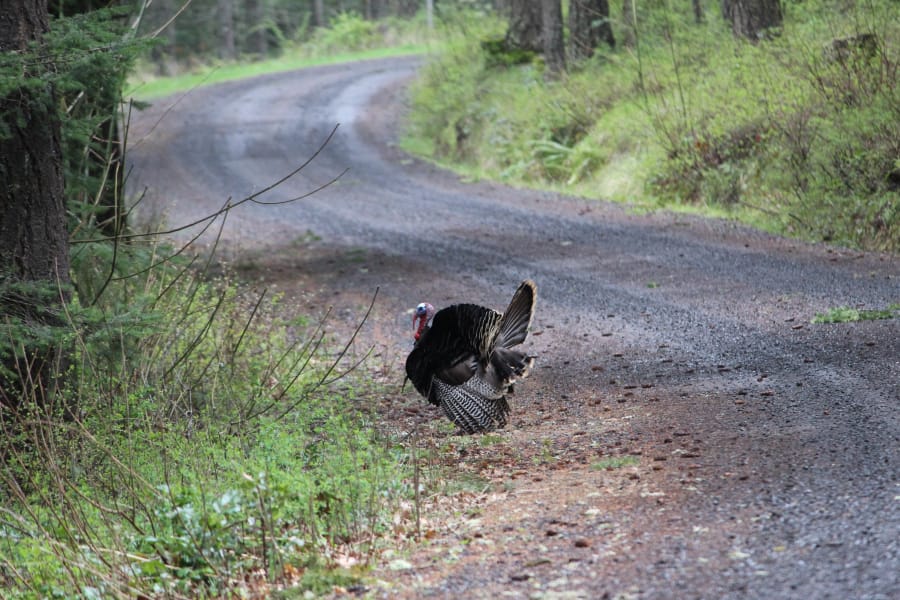Rain fell softly into the damp, dark woods in the predawn darkness. My surroundings slowly took form in the gathering light of dawn, and I soon heard tom turkeys gobbling over a mile away to the east. That caused another group of birds to break into gobbles to the north, once again quite a way off.
Another flock of birds gobbled to the west, not quite as far away as the others. However, there wasn’t so much as a peep anywhere near where I sat. The light sounds of my hen calls got the birds to gobble again, but I knew they were too far away to come to me.
After a few short bursts the birds went silent. That did not surprise me. Wild turkeys do not vocalize much in the rain. Give them a little sun and they will gobble their fool heads off, but I knew the sun would not show itself today.
I was hunting the slopes of Burdoin Mountain north of the Columbia River Gorge city of Bingen. As I came out of the woods, I ran into a couple other hunters that had worked the birds to the west and called in a Jake that they let pass. Jakes are immature gobblers and these gents wanted a mature tom. They reported that the day before, the opening day of the season, they had each taken a bird in this area.
The hunters remarked that it seemed to them that there were more birds around this year than last.
Turkey season opened in Washington on April 15 and will run until the end of May. Hunters must have in their possession a hunting license and turkey tag. Only turkeys with a visible beard may be harvested, and hunters may take the birds with shotguns or with bow and arrow.
Want turkeys? Go east!
There is plenty of time to get out there and fill a turkey tag. But for hunters from Southwest Washington intent on bagging a tom this year, there is a word of advice from a local biologist: Go East.
East into the Columbia River Gorge, that is. Yes, there are turkeys in western Washington. And yes, they are open for hunting. However, they are few and far between. They are the Eastern subspecies of wild turkey, and while hunters do take some every year, it is just a few.
WDFW wildlife biologist Eric Holman reports that the population is small and spread very thin.
“We do not have the kind of turkey numbers in western Washington that you have in Klickitat County,” said Holman.
He explained that the population is spread over a huge area of five or six counties, but that densities are really low.
“They harvested only 30 turkeys in western Washington,” he said of the 2016 season.
By contrast, that same year hunters harvested 461 toms in turkey zone P-35, which includes Klickitat County.
Holman had some advice for local would-be turkey hunters:
“Spend the gas, and go hunt in the Gorge,” he said.
Klickitat County received the very first plants of wild turkeys in Washington back in 1960. The birds were Merriam’s turkeys, a subspecies that originated in the Rocky Mountains and the southwest. They are perfectly at home in the mixed woods of ponderosa pine and oak that cover the Washington hills of the Columbia River Gorge.
In addition to the Eastern and Merriam’s subspecies of wild turkeys, Washington hunters can find the Rio Grande subspecies in parts of the state.
Looking for love
In the spring the tom turkeys spend their days looking for mating opportunities and rarely eat for months, surviving on fats stored in their breast. They gobble loudly to attract hens and spend most of their day strutting, which is puffing themselves up and spreading their tail fan in an attempt to look like the biggest, baddest tom in the woods.
The toms also fight each other constantly for the right to mate with the smaller, less colorful hens.
Turkey hunters attempt to pull the toms into range by using hen turkey calls and decoys. They locate the birds by listening for their distinctive gobble. Tom turkeys will gobble while on the roost, and when they are trying to attract hens on bright days.
The flock in the Gorge is centered in the Klickitat River Valley, although they can be found east to Goldendale, west to eastern Skamania County, and north into Kittitas County.
A good place to hunt them is the Klickitat Wildlife Area. It’s full of turkeys, but that is no secret. Expect company.
At Burdoin Mountain, a patchwork of public lands is interspersed with private holdings. There are good numbers of turkeys here, and even better quantities of poison oak.
The volatile plant completely covers the floor of the oak woodlands. I am allergic to it and if I do pull a tom out of here this year, it will cost me.
As I left the woods that day I watched a lone hen slowly making her way down an old track into a stretch of national forest property I had never hunted. Where the hens go, so follow the toms. I put that spot in the back of my mind for next time out.
The weather will eventually warm up and when the sun finally comes out the birds will be more vocal, more active, and in the mood for love. I’ll be there, listening to the gobbles as they echo off the rugged hills, and hoping to find a lusty tom.
And the rash of poison oak will be worth it.




